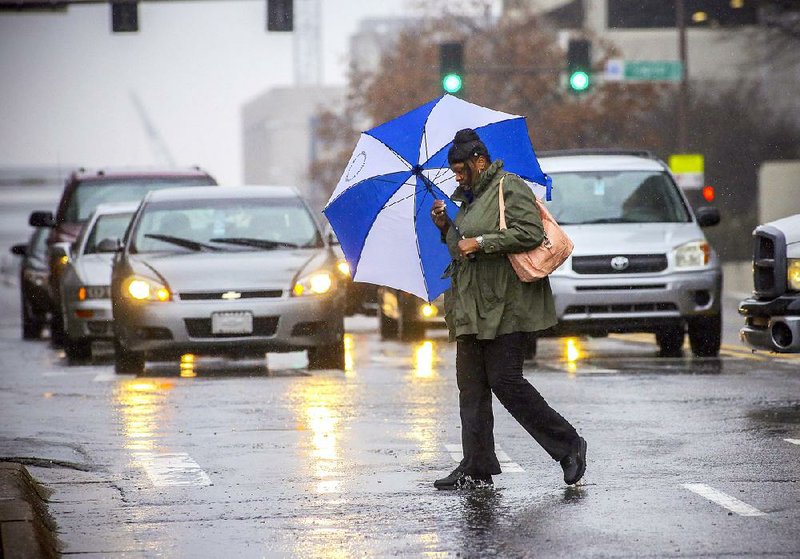Precipitation is well above normal for much of the state this month -- ending a four-month period of below normal totals -- and more rain is expected to soak Arkansas today and Saturday.
The National Weather Service has issued flash flood warnings and watches in all but eight Northwest Arkansas counties through Saturday morning, calling for 3 inches of rain or more over a 36-hour period.
An unseasonably warm, moist air mass entered the state Thursday from the Gulf of Mexico, bringing numerous showers and thunderstorms, forecasters said. It's a change in a weather pattern the state has seen for the past few months in which cold, arctic air dipped in from Canada and met with warm Gulf of Mexico air.
The rainfall will continue to lessen drought conditions in Arkansas. The National Drought Mitigation Center reported Thursday that 53.2 percent of the state remained in some form of drought -- down from 61.8 percent last week.
The center based at the University of Nebraska-Lincoln classifies drought conditions across the United States by evaluating rainfall data, moisture, river levels and other climatological data.
Portions of Cross, Jackson, St. Francis and Woodruff counties are considered in severe drought, a designation given to an area that is 2-4 inches deficient in rainfall over a 30-day period.
Conditions have worsened in Washington and Benton counties, the mitigation center reported. The western two-thirds of each county are classified as in moderate drought, meaning deficient in 1-2 inches of rainfall over a 30-day period.
The rainfall will help that situation.
"This is a good situation with the type of rainfall we're going to get," said National Weather Service meteorologist Pete Snyder of Tulsa. "It's a steady, continual rain lasting through Saturday."
Fayetteville has already received 1.41 inches of rain during the first 11 days of March. Normally, the city sees 1.32 inches of rain over the same period.
Jonesboro's 4.24 inches of rain in March is 2.8 inches more than normal for the first 11 days of March, the weather service said. Little Rock reported a 238 percent increase in rainfall with 3.79 inches, compared with its normal 1.59 inches for the first 11 days in the month.
Texarkana reported the largest increase in rain, and the rainfall is reflected in the drought report. The Miller County city has recorded 5.98 inches of rain over the first 11 days of March -- an increase of 4.43 inches from its normal rainfall.
Last week, Miller County was considered "abnormally dry," meaning it was 1-inch deficit in rainfall over a 30-day period. This week, the Drought Mitigation Center classified the area as drought-free.
Snyder said heavy rain tends to run off rapidly and doesn't always soak into the ground.
Snyder called the mitigation center's designation in Northwest Arkansas more of a "statistical drought," because it's still early in the agricultural season.
"A lot of things are in good shape," he said. "Lake reservoirs are at their caps, there's vegetation beginning.
"You can technically say it's a drought, but it's not really affecting anyone yet."
The rainfall will affect rivers, however.
The Black River at Black Rock is expected to rise to 20.5 feet by Sunday evening. Flood stage in the Lawrence County town is 14 feet. Low-lying farmland on the eastern side of the river is already flooded, and water is encroaching on the city's park and baseball fields.
In Patterson, a Woodruff County town of 452 people, the Cache River is forecast to reach 11.9 feet Sunday. Flood stage there is 8 feet. If the river does rise as expected, it will be the fifth-highest mark recorded there in the past six years.
Homes along Pine Street on the western edge of the town will likely have water reaching their foundations by Sunday, the weather service predicted.
"The ground is pretty saturated," said Gerald Morris, a farmer who has land along the nearby Bayou DeView. "It's not really a problem yet with the [Cache] river, but if we get a lot more rain, we're going to need help."
The Ouachita River crested at 32.5 feet Tuesday after sleet and snow melted in Camden. Flood stage there is 26 feet.
This week's rainfall will cause the river to rise again. It's expected to reach 33.5 feet Saturday morning. Low-lying areas in the Harmony Grove community will be affected, the weather service said.
The most rain is expected to fall in Bradley and Calhoun counties, through the center of Arkansas and toward the northeast corner of the state. Up to 3 inches of rain is expected there, said National Weather Service meteorologist Jeff Hood of North Little Rock.
The rest of the state will see 1-2.5 inches of rain, he said.
"Rivers were low before last week and were fairly receptive to the melting [of snow and sleet]," Hood said. "There is room for filling them up with rain. We were starting to see the rivers begin to go down prior to this event.
"But there wasn't much recovery time, and we're looking for more rain for the latter part of next week," he said.
State Desk on 03/13/2015
